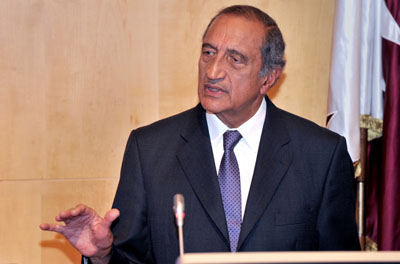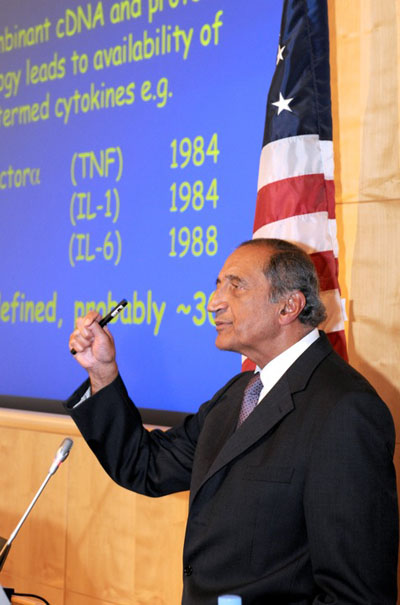Father of Translational Research Speaks at WCMC-Q
February 2011

Dr. Maini, the father of translational research, explores the mechanisms
at play in rheumatoid arthritis and the steps he and his team took to
transform research findings into therapy that relieves millions of people.
Sir Ravinder Maini, FRS, widely considered the father of translational research, spoke at WCMC-Q Monday about the steps that he and his research team took to make a treatment, known as anti-TNF therapy, available to millions of people suffering from rheumatoid arthritis worldwide.
Professor Maini’s presentation, entitled “Bench to Bedside Research and Development of anti-TNF Therapy,” explored the mechanisms and impact of rheumatoid arthritis and the sometimes-uncertain journey he and his team made to parse out the molecular players in the disease and ways to treat it.
“Mine is an unusual story, because although many of us in academic and research medicine undertake the journey that I with my colleagues undertook, very few of us are lucky enough to actually get something at the end of it,” said Dr. Maini. “This is a story that from academia led to a collaboration with industry, which was an essential key step in the provision of this treatment to millions of people.”
Since his primary interest was autoimmune disease, Dr. Maini chose to study rheumatoid arthritis because it was the only such condition that allowed him to extract tissue. The disease affects between .5 and one percent of the adult population, bringing extreme pain, increased risk for cancer and vascular disease, and psychosocial challenges to patients as well as large health care bill to society.

Discovery isn't based on the work of a solo scientist,
Dr. Maini says, it involves the findings of innumerable
members of the research community before benefits
reach the wider public.
To illustrate the personal impact of his team’s findings, Dr. Maini showed a video of a 20 year-old woman with rheumatoid arthritis struggling to climb stairs followed by another video of her running down stairs after she had received anti-TNF therapy in a clinical trial.
Dr. Maini and his long-time collaborator, Mark Feldmen, FMedSci, FAA, FRS, discovered that a key messenger molecule, TNF, was behind many of the cellular activities that lead to rheumatoid arthritis.
For their work, Drs. Maini and Feldmen received the Albert Lasker Clinical Medical Research Award in 2003 and the Crafoord Prize of the Royal Swedish Academy in 2000, among others. Yet Dr. Maini was clear in expressing the fortuitous parallel evolution in genetic and biological medicine that made it possible to target TNF therapeutically.
“Discovery in science is not made by one person,” he said. “I have received many accolades and recognition but they were only possible because there were so many other people whose work was essential to what we were doing--fundamental discoveries in basic science, molecular biology and in genetic biology that were critical to our development of antibodies—called monoclonal antibodies—that were used for treatment.”
Anti-TNF therapy proved effective in roughly 60 percent of patients, while the other 40 percent did not respond, Maini said. Researchers continue to study the treatment and its efficacy.
On a grand scale, however, his team’s finding helped shift the pharmaceutical industry away from an exclusive focus on chemicals toward more investment in biological treatments. Monoclonal antibodies today, he said, exist in increasing numbers for various other diseases and conditions, including cancers, multiple sclerosis, and transplants.
“Anti-TNF therapy persuaded the pharmaceutical industry that you could make progress with these very expensive single molecule inhibitors,” Maini said. “So it opened the door to this kind of treatment.”
By Emily Alp
